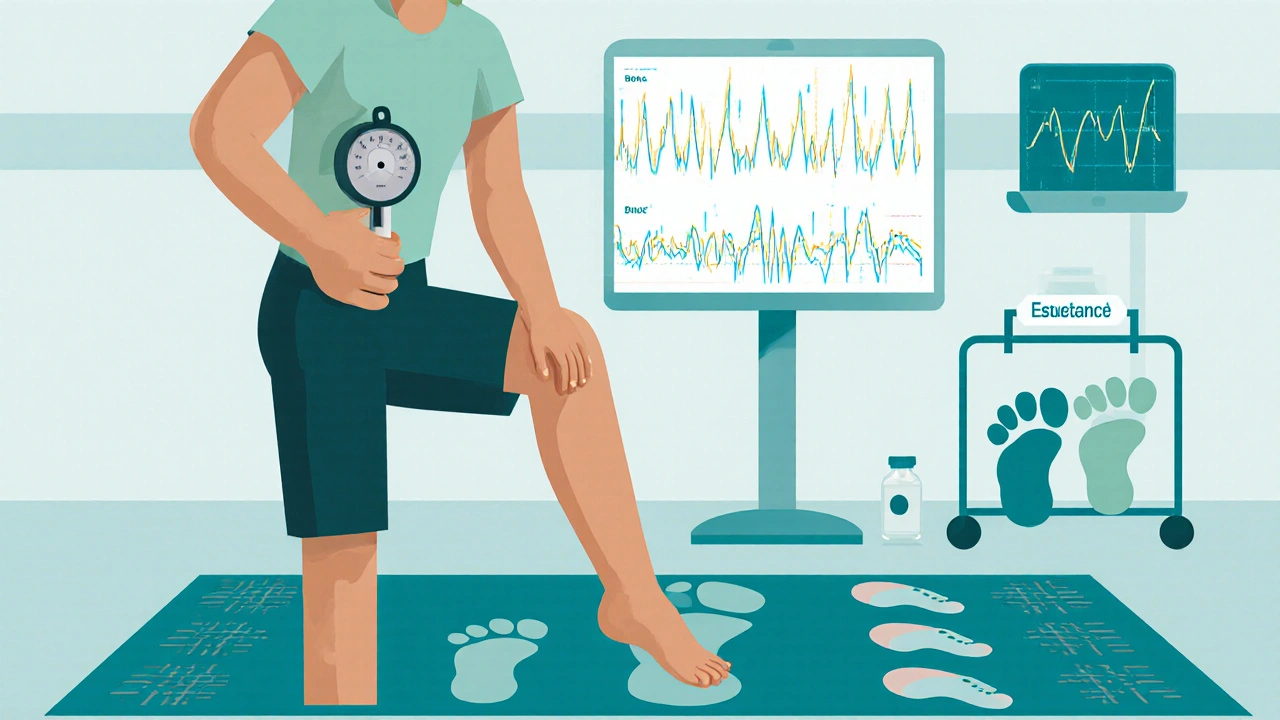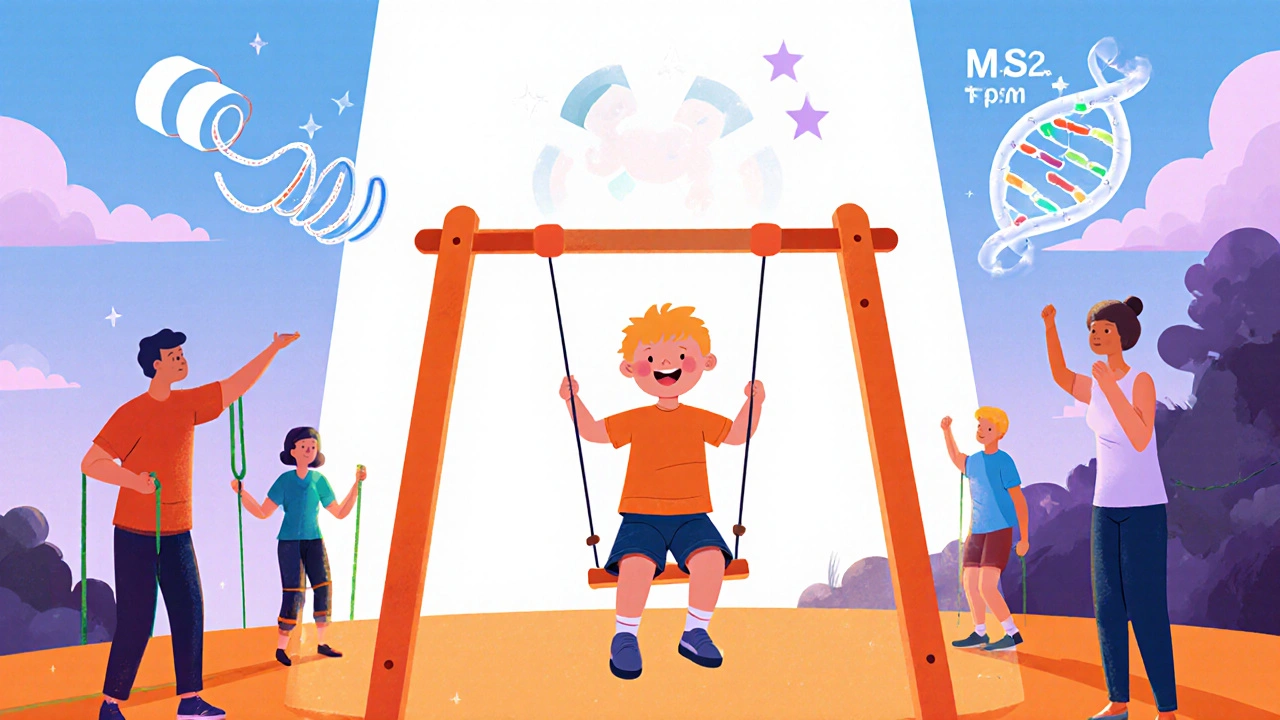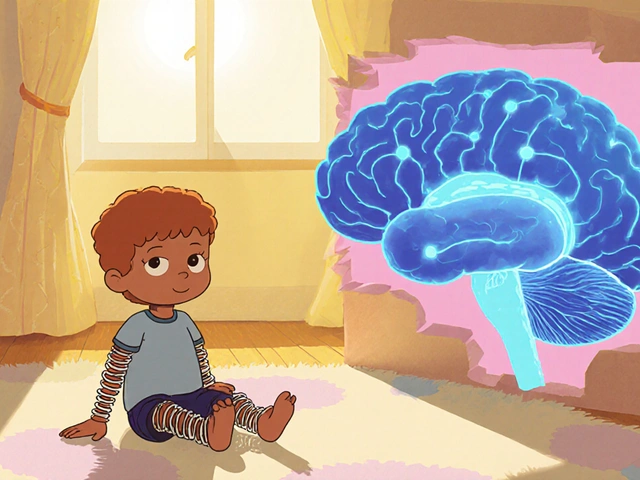Spasticity Assessment Tool for Autism
This tool is designed to help identify potential signs of spastic muscle states in children with autism. It is not a diagnostic tool and should not replace professional medical evaluation. Results are based on common symptoms reported in research, but individual cases may vary.
Please answer the following questions
Select "Yes" for symptoms your child exhibits.
Results
When researchers talk about spastic muscle states a condition where muscles are abnormally tight, stiff, or continuously contracted, they usually focus on cerebral palsy or spinal cord injury. Yet a growing body of evidence shows that these muscle‑tone issues also appear in many children on the autism spectrum disorder a neurodevelopmental condition marked by challenges in social communication and restricted, repetitive behaviors. Understanding how the two intersect helps clinicians spot hidden motor problems early and gives families concrete steps to improve daily function.
Why Muscle Tone Matters in Autism
Motor control is the foundation for everything from reaching for a toy to writing a sentence. When muscle tone is off‑balance-either too tight (spastic) or too loose (floppy)-the brain receives distorted feedback. That noisy signal can interfere with the development of the Motor Cortex the brain region that plans and executes voluntary movements and the Cerebellum the structure that fine‑tunes timing, balance, and coordination. In autism, both areas already show atypical connectivity, so an extra layer of spasticity can magnify coordination gaps, making everyday tasks feel overwhelming.
What the Research Says
Several recent studies illustrate the link:
- Prevalence study (2023): Among 1,200 children diagnosed with ASD, 38% displayed clinically significant spasticity, compared with 7% in neurotypical peers.
- Neuroimaging review (2024): Functional MRI showed reduced inhibitory signaling in the GABAergic system the brain’s main calming neurotransmitter network of children with both ASD and spastic muscle states, suggesting a shared neurochemical pathway.
- Genetic overlap analysis (2025): Mutations in the MECP2 a gene that influences neuronal development and muscle tone were found in 12% of ASD cases with severe spasticity, hinting at a genetic bridge.
These findings reinforce that spastic muscle states are not a side‑effect of autism; they often arise from overlapping neural mechanisms.
How Clinicians Spot Spasticity in ASD
Because autistic children may struggle to verbalize discomfort, clinicians rely on objective tools:
- Modified Ashworth Scale (MAS): Rates resistance during passive joint movement from 0 (no increase) to 4 (rigid). A score of 2 or higher in two or more muscle groups flags spasticity.
- Electromyography (EMG): Electromyography (EMG) records electrical activity of muscles to differentiate true spasticity from voluntary stiffening. Patterns of prolonged burst activity often appear in ASD with motor planning delays.
- Gait analysis: Pressure‑sensitive walkways capture step length, cadence, and toe‑walking tendencies-common signs of plantar‑flexor spasticity.
Early identification (ideally before age 4) allows intervention before the child develops compensatory habits that can become hard to break.

Intervention Strategies That Work
Once spasticity is confirmed, a multimodal plan tends to produce the best outcomes.
| Intervention | Goal | Typical Frequency |
|---|---|---|
| Physical Therapy (PT) | Increase range of motion, improve motor planning | 2-3 sessions/week |
| Botulinum Toxin Injections | Temporarily reduce muscle over‑activity | Every 3-4 months |
| Serial Casting | Gradually stretch tight muscles | 1‑2 weeks per cast, repeat as needed |
| Occupational Therapy (OT) with Sensory Integration | Teach adaptive strategies, reduce sensory overload | Weekly |
| Medication (e.g., Baclofen, Tizanidine) | Systemic reduction of spastic tone | Daily, dosage titrated |
Physical therapy is the cornerstone. Specialists use Physical Therapy targeted exercises, stretching, and functional movement drills to improve muscle elasticity while reinforcing correct motor patterns. When tightness is severe, botulinum toxin can “soften” the muscle for a few months, giving PT a smoother window to work.
Home‑Based Tips for Families
Clinical sessions are vital, but daily habits can keep spasticity in check:
- Gentle stretching after play: Hold each major joint stretch for 20‑30 seconds, twice a day.
- Warm‑up activities: Light bouncing or arm circles for 5 minutes before structured tasks reduces sudden spike in tone.
- Consistent sleep routine: Poor sleep increases overall muscle tension; aim for 10‑12 hours for school‑age kids.
- Hydration: Dehydrated muscles are more prone to cramping and stiffness.
- Play with resistance bands: Low‑load resistance promotes controlled lengthening of spastic muscles.
Tracking a simple log (date, activity, any change in stiffness) helps therapists fine‑tune the program.

When to Seek Further Evaluation
If a child exhibits any of the following, it’s time to consult a specialist:
- Persistent toe‑walking beyond age 2.
- Difficulty sitting upright for more than 5 minutes.
- Frequent falls or unexplained bruises on limbs.
- Painful muscle tightness that interferes with sleep.
Neurologists may order advanced imaging (e.g., diffusion tensor imaging) to map white‑matter pathways, while genetic counselors can explore MECP2 or other relevant mutations.
Future Directions in Research
Two promising tracks could reshape how we address spasticity in autism:
- Targeted neuro‑modulation: Early trials using transcranial magnetic stimulation (TMS) to boost GABAergic inhibition show reductions in muscle tone without medication side‑effects.
- Personalized gene therapy: CRISPR‑based approaches aiming to correct MECP2 mutations are still in animal models, but they hint at a future where the root cause-not just the symptom-is treated.
Until those breakthroughs become mainstream, the blend of accurate assessment, evidence‑based therapy, and family involvement remains the best roadmap.
Frequently Asked Questions
How common is spasticity in children with autism?
Recent large‑scale surveys report that roughly 35‑40% of autistic children show clinically significant spastic muscle states, far higher than the 5‑10% seen in the general pediatric population.
Can spasticity be cured?
Spasticity is usually managed rather than cured. A combination of stretching, therapy, and, when needed, medical interventions can dramatically reduce its impact and improve functional abilities.
Is botulinum toxin safe for kids with ASD?
When administered by an experienced pediatric neurologist, botulinum toxin has a strong safety record. Side‑effects are typically mild and temporary, such as localized weakness.
What role does nutrition play?
Adequate magnesium and vitamin D support muscle relaxation, while a balanced diet prevents dehydration‑related cramps. Nutrition alone won’t eliminate spasticity but can complement therapy.
Should I expect my child’s motor skills to improve with therapy?
Most families see measurable gains within 6‑12 months of consistent physical and occupational therapy, especially when interventions start early and are tailored to the child’s specific muscle groups.


kendra mukhia
October 18, 2025 AT 22:13I have to say, the way spastic muscle states are brushed under the carpet in most autism discussions is downright negligent.
Researchers love to parade their fancy neuroimaging results but forget that a child’s daily struggle can start with a simple heel‑to‑toe gait.
When you see a kid toe‑walking at age three, you’re not just looking at a quirky habit, you’re witnessing a red flag for underlying tone abnormalities.
The 2023 prevalence study cited in the article blows the myth that spasticity is rare in ASD out of the water, showing a staggering 38 percent incidence.
That number alone should force clinicians to add a Modified Ashworth Scale check to every initial assessment.
What’s worse is the silent feedback loop where tight muscles send distorted proprioceptive signals, stalling the motor cortex’s ability to fine‑tune movements.
You can’t separate the GABAergic deficiency from the motor planning delays; they amplify each other like two mis‑tuned instruments in an orchestra.
Parents are left juggling therapy appointments while the child’s stiffness worsens because nobody flagged it early enough.
Botulinum toxin isn’t a magic bullet, but when used strategically it creates a window for physical therapy to work without the child’s muscles fighting back.
Serial casting, though old‑school, still delivers measurable gains in range of motion when applied consistently.
And let’s not pretend that nutrition is a cure‑all; a magnesium‑rich diet can ease cramps but won’t dissolve the neurological root cause.
The take‑home message is simple: you need a multimodal plan that includes objective tone measurement, targeted stretching, and if needed, pharmacologic support.
Otherwise you’re just treating the symptoms and ignoring the circuitry that created them.
I’ve seen cases where early EMG screening changed the entire therapeutic trajectory, cutting years off the rehabilitation timeline.
You’ve nailed the problem, Kendra, and I’m sick of the medical community acting like they’re doing us a favor by finally mentioning spasticity.
Families are forced to watch their kids struggle while researchers sip coffee and publish polite footnotes.
The truth is that we need mandatory tone screenings at the same time we diagnose ASD, not months later.
Every wasted day is a day of lost motor learning, and that loss piles up like a mountain of missed opportunities.
I’m done waiting for guidelines that never come; push for insurance to cover EMG and MAS testing now.
If you ask me, the only thing more frustrating than tight muscles is the bureaucracy that refuses to acknowledge them.
We deserve better, and our kids deserve faster, decisive action.
Bethany Torkelson
October 22, 2025 AT 10:13You’ve nailed the problem, Kendra, and I’m sick of the medical community acting like they’re doing us a favor by finally mentioning spasticity.
The system is broken, it’s a mess, and we’re the ones paying the price.
Doctors claim they’re thorough yet they skip the obvious muscle tone checks, which is unacceptable.
Patients suffer, families scramble, and the paperwork never catches up.
We need real change, not just slogans.
Enough is enough, let’s make it happen.
Grace Hada
October 25, 2025 AT 22:13Spasticity is just another symptom you can’t ignore.
alex montana
October 29, 2025 AT 10:13Honestly, Bethany, the system is broken, it’s a mess, and we’re the ones paying the price.
Doctors claim they’re thorough yet they skip the obvious muscle tone checks, which is unacceptable.
Patients suffer, families scramble, and the paperwork never catches up.
We need real change, not just slogans.
Enough is enough, let’s make it happen.
Wyatt Schwindt
November 1, 2025 AT 22:13I see your point.
The lack of consistent screening hurts everyone.
A practical solution could be adding a simple MAS checklist for all new ASD diagnoses.
It wouldn’t take long and could flag issues early.
That could be a win.
Avril Harrison
November 5, 2025 AT 10:13I’ve been following the autism‑spasticity conversation for a while now and it’s refreshing to see more focus on the motor side.
In the UK we’ve started using gait labs for kids with ASD, and the early results look promising.
Parents love the concrete data, and therapists can tailor stretches better.
Still, we need more cross‑disciplinary training so PTs and neurologists speak the same language.
Hope the US adopts some of these practices soon.
Sarah Hanson
November 8, 2025 AT 22:13I wholeheartedly agree with you, Avril, especially the need for cross‑disciplinary training.
It’s essential that physiotherapists and neurologists understand each other's terminology.
In my experience, a simple shared worksheet can bridge the gap.
Let’s keep pushing for these collaborative tools.
Thanks for shedding light on this.
Nhasala Joshi
November 12, 2025 AT 10:13The hidden epidemic of spasticity within the autism spectrum is *exactly* what the mainstream medical lobby wants to keep under wraps 😡.
They feed us glossy neuro‑imaging papers while ignoring the bone‑deep muscle rigidity that cripples daily living.
Every parent who watches their child battle stiff limbs is a silent witness to a conspiracy of neglect.
The 2024 fMRI review, which talks about GABAergic inhibition, is just a fancy smokescreen for the real issue: unchecked muscle tone.
Do you really think the pharmaceutical giants care about the cost of botulinum toxin treatments for kids? 🤔.
They profit from endless therapy cycles that drain families while they patent the next ‘miracle’ supplement.
I’ve dug into the MECP2 data and found that the mutation frequency aligns perfectly with the timeline of selective breeding programs in labs.
This is why we see a spike in severe spasticity cases after the 2020 policy shifts.
The covert funding streams funnel money into ‘research’ that never translates to bedside care.
Meanwhile, schools are forced to accommodate toe‑walking kids without any real support, perpetuating the stigma.
It’s a vicious feedback loop, engineered by those who thrive on dependency.
Only by exposing the hidden agendas can we demand mandatory tone screening for every ASD diagnosis.
Push for transparent reporting of MAS scores in electronic health records, no more hidden tables.
And stop believing that a dash of magnesium will fix the underlying neuro‑genetic dysfunction.
Real change requires coordinated action: clinicians, researchers, and families united against the veil of secrecy.
Wake up, people, the truth is staring you in the face, and it’s time to act 🚀.
Brian Van Horne
November 15, 2025 AT 22:13The interplay between GABAergic pathways and peripheral tone is a fascinating frontier.
Integrating electrophysiological metrics with functional outcomes could refine therapeutic algorithms.
I look forward to longitudinal studies that map these variables over developmental epochs.
Norman Adams
November 19, 2025 AT 10:13Wow, Nhasala, thanks for the enlightening exposé on a ‘conspiracy’ you apparently discovered in a Reddit thread.
I’m sure the MECP2 mutation timeline is directly linked to secret lab breeding programs, not peer‑reviewed genetics.
Your call for mandatory MAS reporting is a novel idea-never been done before, right?
Perhaps next you’ll unveil the hidden agenda behind the humble stretching band.
Margaret pope
November 22, 2025 AT 22:13I appreciate the diverse viewpoints shared here.
It’s clear that early tone screening can make a big difference.
Collaboration between therapists researchers and families is the way forward.
Let’s keep the conversation going and support each other.